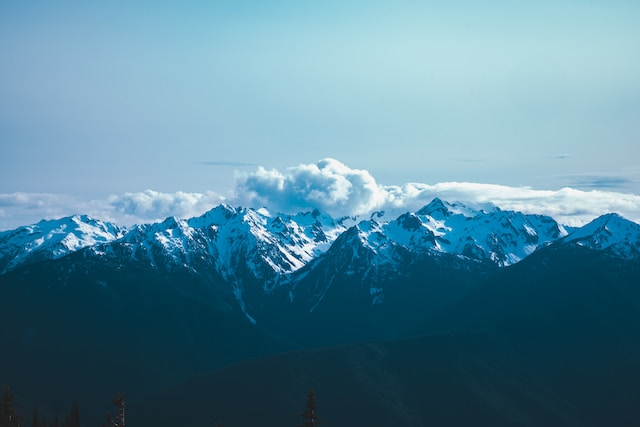
Washington state is in the heart of the Pacific Northwest and is known for its diverse ecosystems and breathtaking landscapes. From a tranquil ferry ride out to the iconic San Juan Islands to a vigorous hike to the peaks of the Cascade Range, locals and travelers alike have plenty of outdoor activities to choose from.
So, let’s expand your sights beyond Seattle with the best hidden treasures that exemplify the beauty and diversity of Washington State. From popular must-see spots to lesser-known U.S. national parks, there’s plenty of wilderness to explore.

1. Olympic National Park: A land of diversity
Olympic National Park spans nearly one million acres and is home to a trove of ancient forests rising from scenic lakes. Visitors often head to this park to visit Mount Olympus, a snow-capped peak that rises 7,980 feet into the sky.
But those looking for a more immersive experience can head to the Hoh Rain Forest to catch unparalleled views along the Hurricane Ridge. Lake Crescent is another popular spot in the park and is perfect for picnicking or enjoying water activities in the warmer months.

2. Mount Rainier National Park: The iconic peak
This National Park is home to the active volcano Mount Rainer, a peak that rises to 14,411 feet and is the most prominent landmark in Washington State. Outdoor enthusiasts have access to over 260 miles of hiking trails that wind through wildflower meadows, old-growth forests, and roaring waterfalls.
Established in 1899, this park offers two top-tier visitor centers that provide unique perspectives on the mountain itself and its surrounding area. So make sure to swing by for a rundown as well as helpful maps before you explore this natural wonder.

3. North Cascades National Park: A hiker’s paradise
About three hours from Seattle and along the scenic State Route 20 is the North Cascades National Park, a stretch of majestic wilderness that’s known for its jagged mountain peeks giving away to dramatically forested valleys. This National Park contains over 300 glaciers, more than any U.S. park outside of Alaska. It’s ranked as one of the best National Parks in the US for good reason, offering once-in-a-lifetime views and activities.
Make time to hike or find a good view of Goode Mountain, a 9,220-foot natural landmark that’s the crown jewel of the park. Ross Lake is perfect for water activities year-long, from swimming to ice fishing to kayaking in the 23-mile-long reservoir.

4. San Juan Islands National Monument: A marine wonderland
Marine lovers can head out on Washington’s beloved Puget Sound to experience an archipelago of no less than 450 San Juan Islands. The three most popular islands are Lopez, Orcas, and San Juan Island. Visitors can travel to the San Juan Islands via ferry or take a whale-watching excursion from Seattle.
You can expect to see sea lions, humpback whales, porpoises, and other sea life during your visit. If you want to get closer, set out on a kayak or go scuba diving and explore the underwater world around you. If you want to wake up to a gorgeous sunrise or catch the sunset, there are year-round campsites as well as lodges to choose from.
These are some of the best islands that are accessible in the states for getting off the beaten track and enjoying the beauty of the Pacific Northwest. Keep in mind that this is a chilly location year-round, so pack and dress appropriately, even if you’re heading out to this natural landmark in the middle of July.

5. Ebey’s Landing National Historical Reserve: A glimpse into the past
At 4,589 acres, Ebey’s Landing National Historical Reserve encompasses both timeless nature and American history on its grounds. It’s nestled on Whidbey Island in Puget Sound and boasts coastal views on both sides of its boundaries. There are three state parks on the island that provide plenty of variety for a day trip or longer stay.
There are miles of diverse hiking trails, scenic fishing spots, and sandy beaches for visitors to enjoy. History buffs can enjoy a self-guided walking tour in the historic town of Coupeville or swing into the Island County Historical Museum to learn more about the island’s unique past.

6. Mt. Baker-Snoqualmie National Forest: Geologically diverse and rich
The Mt. Baker-Snoqualmie National Forest is part of a young volcanic field that has been active for the past 1.3 million years. On top of this geologically active location, visitors can enjoy a myriad of activities. Hiking the Heliptrop Ridge and Skyline Divide provides sweeping views of Mount Baker as well as up-close looks at the glaciers, plants, and wildlife.
Skiing and snowboarding are available, and in the winter, waterfalls in the locale are transformed into majestic walls of ice. The area is also known for its exceptional birding opportunities, with over 300 species being spotted in the forest.
For those who don’t have a lot of time for full or multi-day excursions, a scenic drive through the forest is still worth a visit. Enjoy a break by heading to Artists Point, a vista that inspires visitors and has been photographed by many.

7. Gifford Pinchot National Forest: Cave exploration opportunities
Gifford Pinchot National Forest boasts over 1.3 million acres of forest and is a great option for those looking to beat the crowds at other more popular parks in Washington State. It’s home to the Mount St. Helens National Volcanic Monument, as well as Mt. Adams. This park was first established in 1908, and visitors can learn about and explore the interesting lava tubes and caves.
The famous Ape Cave has two access points. Those looking for an easier experience can take the steps down to the lower trail. Experienced scramblers and climbers may want to opt for the upper trail, which offers a more intimate experience with the cave’s landscape.



